One common problem gar owners face, their limited compatibility with other fish species. In this article, we have gathered every bit of information about Gars Tank Mates.
Gars are very popular among aquarists because of their unique, elongated bodies and long jaws.
Because of their large size and specialized care needs, they are recommended only for experienced aquarists.
Some gars grow up to 10 feet long while others only reach about 2 to 3 feet maximum. If space is not a problem for you, you can keep any gar species you want in captivity.
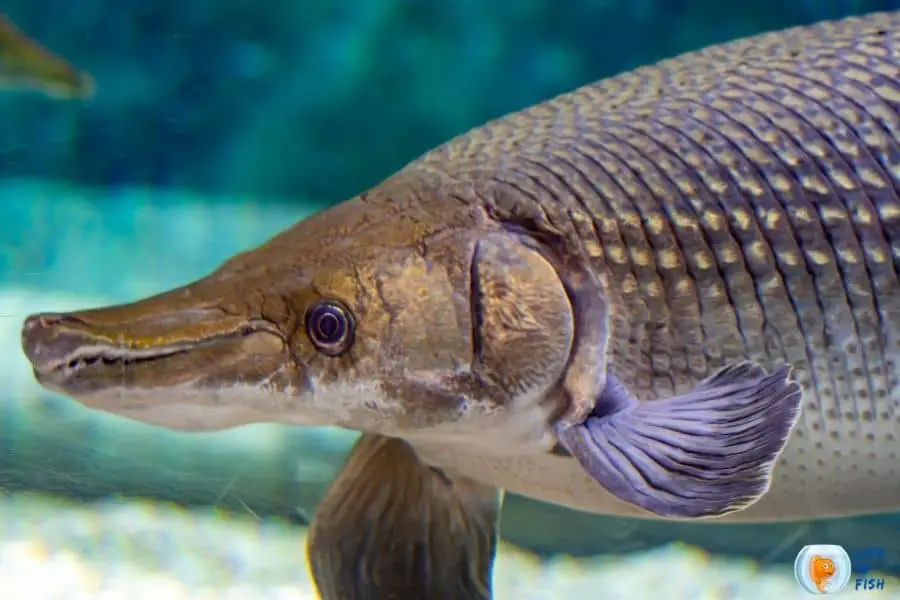
Gars description
Jump To
Gars are a unique species of fish that belong to a family called Lepisosteidae.
They have long, elongated bodies and jaws and are found worldwide at depths of up to 100 meters in freshwater bodies.
There are seven living gar species that inhabit North and Central America, Sri Lanka, India, and Malaysia, while many other species have already gone extinct.
The two most common and well-known species of gar are longnose gar and alligator gar.
You can find these predatory fish mostly in freshwater habitats, but they also live in brackish waters as well as marine waters sometimes.
Gar species
As we said above, there are seven living gar species found all around the world. They vary in size, color, geographical distribution, and even their diet.
Longnose gar (Lepisosteus osseus)
The longnose gar is one of the largest types of gars that can reach up to 6 feet in length when fully grown.
The fish has a body completely covered with brown spots and stripes, while their long snout has two rows of sharp teeth.
The longnose gar inhabits large rivers in North America, including the Mississippi River, where it preys on other fish species like catfish.
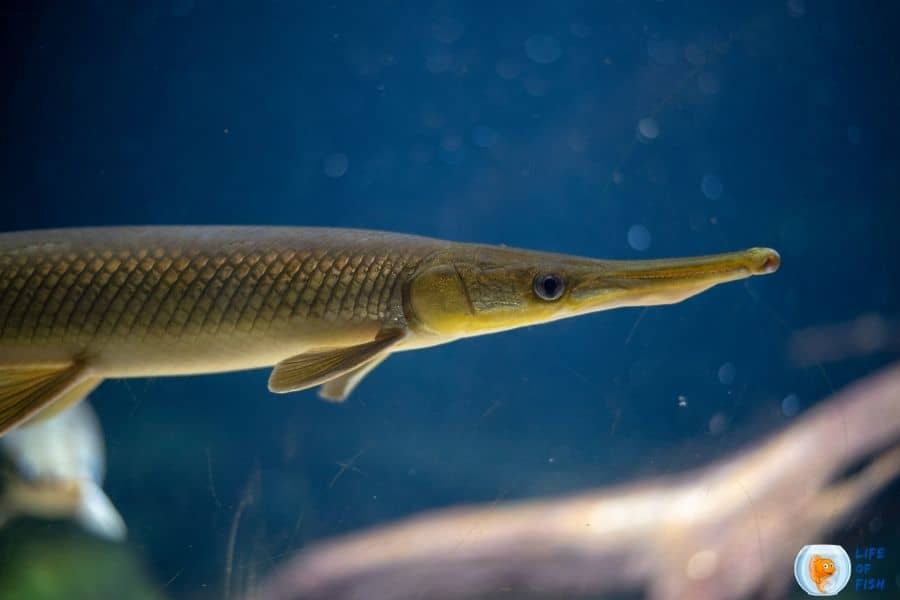
Alligator Gars (Atractosteus spatula)
The Alligator Gar is commonly found in the southern United States, where it inhabits sluggish backwaters, pools, and bayous.
Alligator gar has a large mouth with very sharp teeth perfect for catching its prey.
Alligator Gar can reach up to 10 feet in length, making it the largest gar species in the world.
The alligator gar is greyish-green with darker vertical bands and spots on its body, whereas its head is dark green or gray.
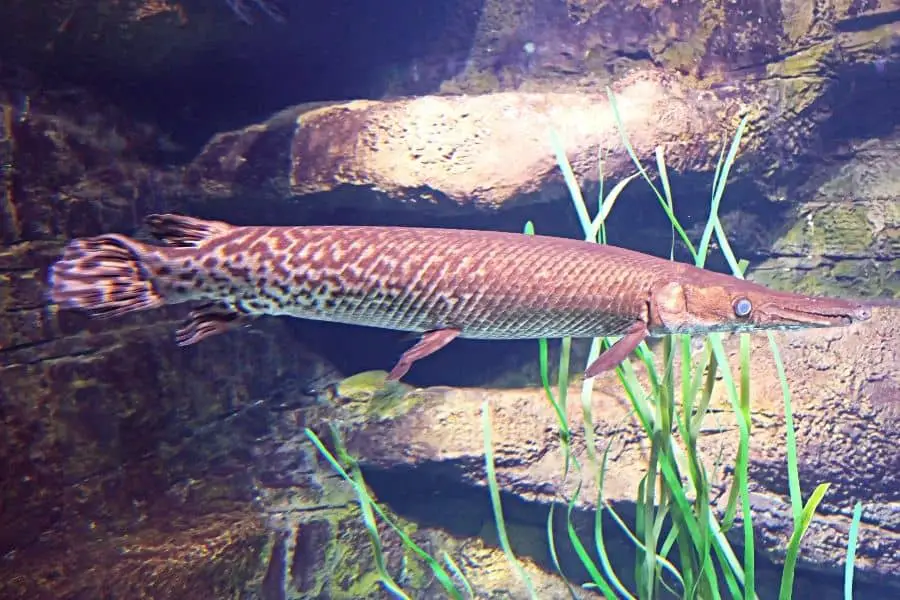
Spotted Gars (Lepisosteus oculatus)
The spotted gar is smaller than other types of gars, growing up to 3 feet in length.
It has a spotted dart-like body, a long snout, and a large mouth with sharp teeth to catch prey like smaller fish species.
Spotted gars are distributed across North America, where they inhabit creeks, lakes, and rivers. They also live in brackish waters sometimes.
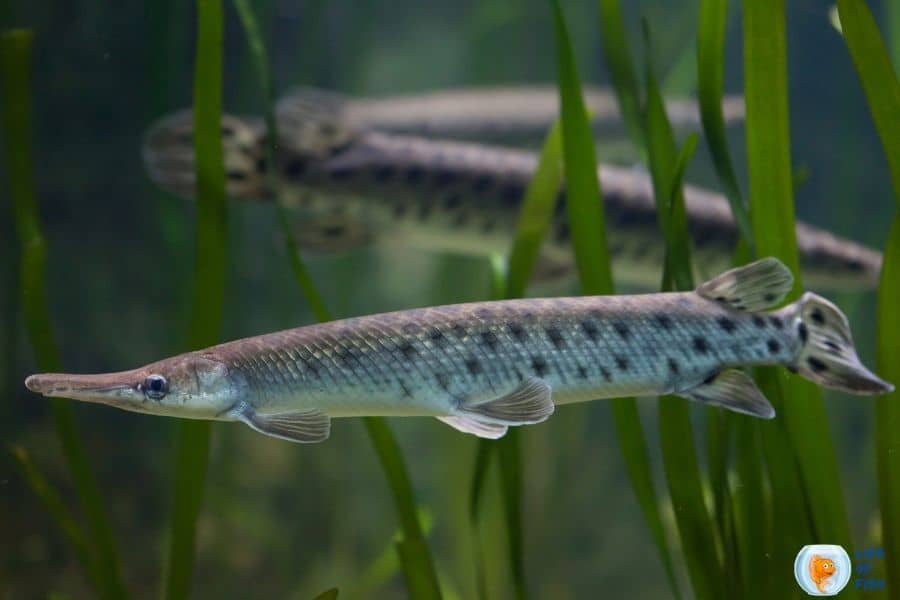
Florida Gars (Lepisosteus platyrhincus)
The Florida gar is a large fish found in the United States in freshwater habitats, bayous, and sluggish backwaters. It is distributed across the state of Florida in North America.
The Florida gar grows up to 4 feet long, although some even grow larger than that size. It inhabits freshwater habitats like lakes, rivers, swamps, ponds, and estuaries.
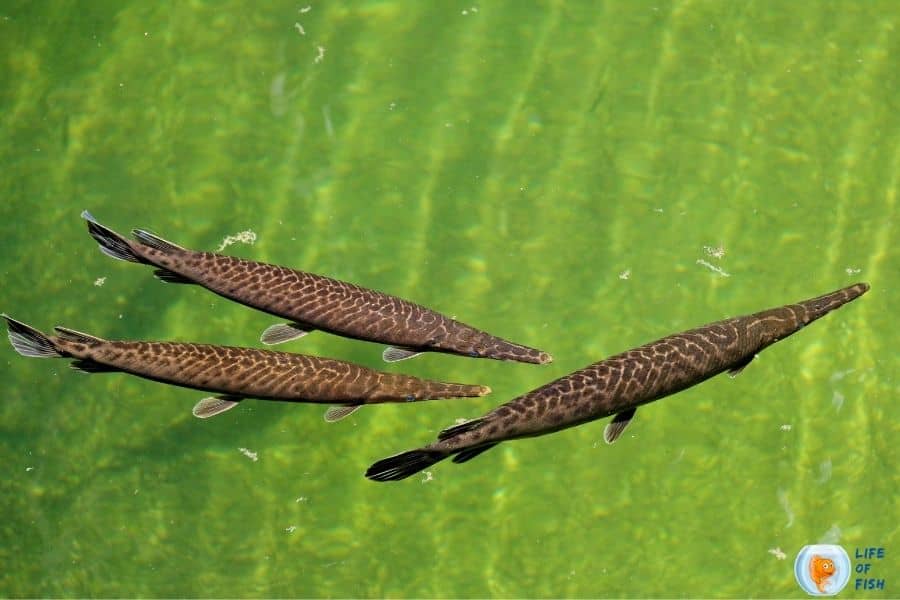
Shortnose Gars (Lepisosteus platostomus)
The shortnose gar is one of the smallest gar species, growing up to 3 feet in length.
It is found throughout North America, where it inhabits sluggish backwaters, ponds, and sluggish creeks connected with larger rivers.
The shortnose gar has a brownish-gray-colored body with two rows of dark spots on each side. Sometimes you can also find this species in brackish water habitats.
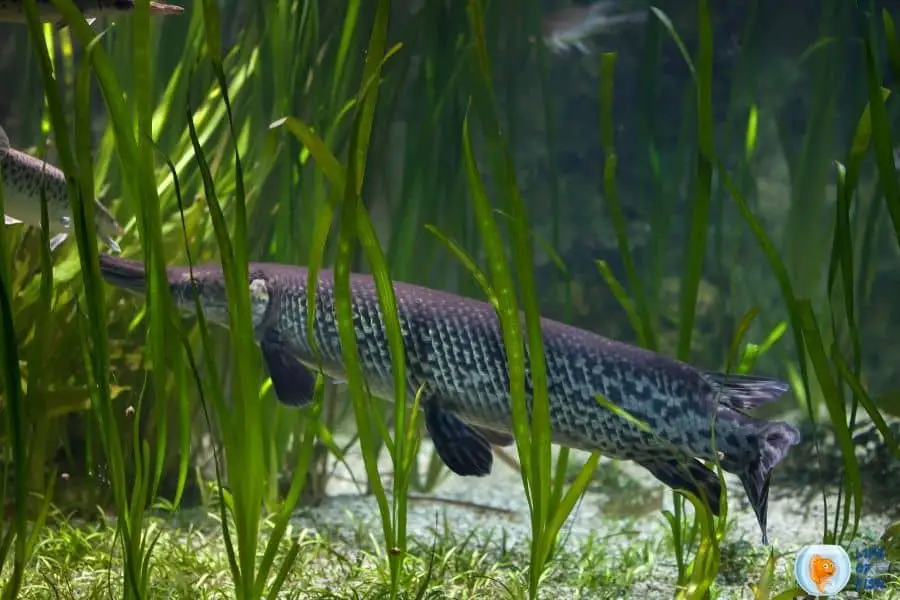
Cuban Gars (Atractosteus tristoechus)
The Cuban gar is a large species of gar that can grow up to 7 feet in length.
The fish is native to Cuba and inhabits freshwater habitats like rivers and lakes and sometimes brackish waters.
Cuban gars have a long, pointed snout with sharp teeth to hunt smaller fish species. They are darkly colored with light spots on their body and also have dark-colored heads.
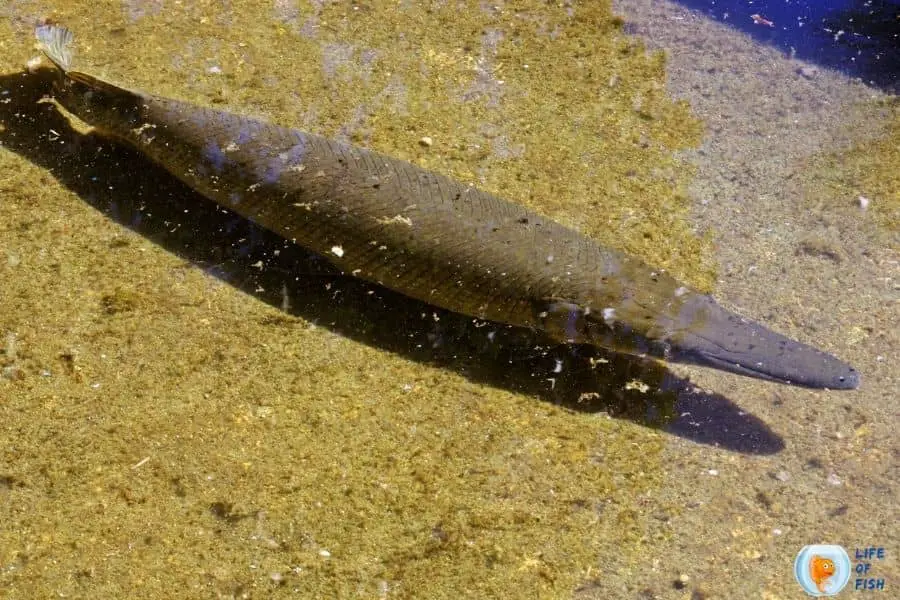
Tropical Gars (Atractosteus tropicus)
The tropical gar is a large fish that can grow up to 4 feet in length. It is found in Central and South America, inhabiting slow-moving waters like swamps and rivers with thick vegetation.
The tropical gar has a dark-colored body covered with lighter spots and stripes and a spotted or striped head, making it easy to recognize this species.
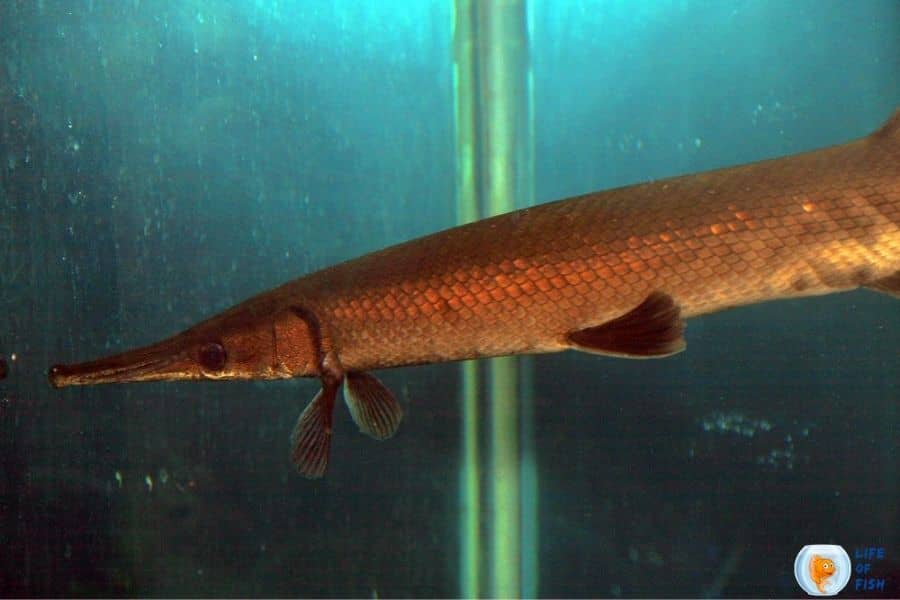
Minimum tank size for gars
The minimum tank size varies according to the fish species, and you will need a tank of at least four times the fish’s length and twice the fish’s size in width.
So, if you own a 3 to 4 feet long gar, you will have to provide at least 500 gallons tank or pond.
If you want more than one gar, make sure that your tank is large enough for them as well.
A couple of spotted gars can live in a tank of a minimum of 1000 gallons. To keep an alligator gar, you will need a much larger tank similar to a public aquarium.
Gars Tank Mates
The first thing you should know is that Gars are not really community fish. You can’t keep them with other aquarium fishes because they will be eaten sooner or later.
They are ambush predators and would never pass up on an opportunity for a good meal.
Because of this, you have to choose whichever kind of fish you want to keep with your gar. However, gars are slow swimmers, and smaller species of fish could easily evade them.
So, if you’re going to keep gars and other types of fish that are slower in speed, it’s possible, but make sure that the tank has plenty of aquatic plants because gar is a habitat-based fish.
Gar tank mates may change according to the species which we discuss below.
Alligator Gar Tank Mates
Since Alligator gars grow too big for a freshwater species, it is extremely difficult to find compatible large fish species.
Most large aquarium fish species are small enough for these fish to eat when they reach their maximum size.
However, they take much longer to grow to their full potential so that you can house some larger peaceful fish species for an extended period of time.
Some compatible fish species are,
- Channel Catfish
- larger black basses
- Bowfins
You can also house small fish species with these species because they are too small to register as food. For example, you can house guppies and mollies with Alligator gars.
Spotted Gar Tank Mates
Spotted gar is the smallest gar species that can be kept at home aquaria. Because of their small size, you have several options as large tank mates. Some of them are,
- Arowana species
- Polypterids
- Oscars
- bichirs
- fire eels
- albino channel catfish
Because of their smaller size, small aquarium fish species may not be a good option because they may become prey for spotted gars because of their smaller size.
Longnose Gar Tank Mates
Although longnose gars have a fearsome reputation, they are quite timid fish species.
So they can be housed with large fish species like Centrarchids, large cichlids, Channel catfish, and large Loricariids. African cichlids are a good choice for longnose gars.
Florida Gar Tank Mates
Florida gars are also on the smaller side of gars, so you have several tank mate options for them. Some compatible tank mates are,
- knife fish
- bichirs
- some cichlids
- Oscars
- Firemouth cichlids
- lungfish
- African Arowana
Because they are smaller, small aquarium fish species might not be a suitable option because Florida gars would eat them.
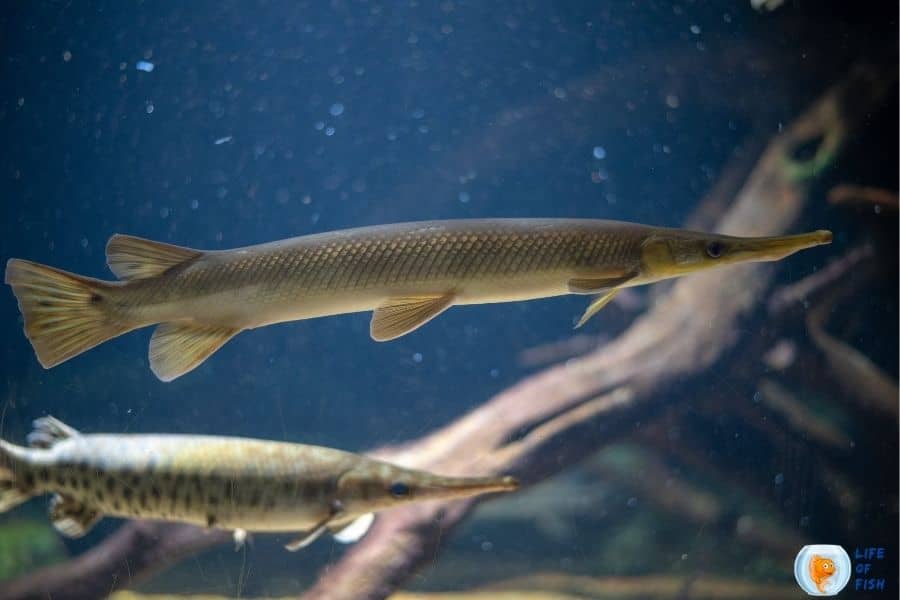
Shortnose Gar Tank Mates
Shortnose gars are also one of the smallest species of the gar family. They are usually kept with other large species because it is difficult to house multiple shortnose gars together.
Some compatible tank mates for them are,
- albino channel catfish
- large cichlids like Texas cichlid Herichthys cyanoguttatus
- African knifefish
- cichlids like firemouth cichlid
- bichirs
- Polypterids
- Oscars
- Golden Dorado
- Arowana species
Shortnose gar is also not big enough to have problems with smaller fish species. The only issue is that they may eat small fish species, so you should choose larger tank mates for them.
Cuban Gar Tank Mates
Cuban gar is a larger species, so you have plenty of potential tank mates for them.
These fish are usually kept with large species like Loricariids, Knife fish, Polypterid, large Arowana species, etc.
However, because they are slower in speed but aggressive by nature, it is not good to keep slow fish species with them as they may become the prey of Cuban gar.
You can house fish species like guppies, mollies, and other small fish species with them because they are too small to register as food.
Tropical Gar Tank Mates
The Tropical gar is a medium-sized gar species. They are usually kept with large species because it is not possible to house them in small tanks.
Some of the best tank mates for them are,
- large cichlids like Texas cichlid
- Arowana species
- alligator gar
- Oscars
Large Central and South American cichlids can be a good choice too. Besides the large cichlids, you can keep them with knifefish, bichirs, and Arowana species.
Same Species Compatibility
All gar species are very territorial and aggressive by nature, so it is not a good idea to house multiple subs larger than 20 inches in length together, even though some people claim to be able to do it.
If you intend to keep a large fish tank with gar species, then try having one or two small ones together because larger specimens of all gar species are aggressive by nature.
Aggression varies among the species, but in most cases, they are aggressive toward others.
Some of the gar species are small so that you can keep them together with other fish species.
These include Spotted, Florida, and shortnose gars. However, some studies claim that Shortnose Gar may be territorial towards others of their own species. So you should avoid housing them together.
Other species like the alligator gar and tropical gar are larger and can be housed with large cichlids like Texas Cichlid (Herichthys cyanoguttatus) and African cichlids etc.
Tropical Gar is more peaceful than other gars. So it can be kept with other fish species of similar size.
Recently asked questions
What is the smallest species of gar?
The smallest species of gars is Shortnose gar. They are usually around 2 feet in length but have been reported to be as long as 3 ft.
Does gar need an air pump?
You can keep gars without aeration or an air pump because they can survive without it. They come from shallow rivers and lakes, so they are comfortable in still waters.
What is the world record alligator gar?
The world record of alligator gar is 8 ft 5 in long. Kenny Williams caught it in 2011 at oxbow lake of the Mississippi River, where it weighed 327 pounds.
Conclusion
When it comes to gar tank mates, the options are limited. Keeping multiple small gar species together is possible, but larger ones should be kept one by one because they are aggressive by nature.
As a rule of thumb, gar tank mate should be large enough not to fit in gar’s mouth or too small to register as prey.
Do not house aggressive tank mates with gars because they may prey on them, especially if the gar is too small to defend itself.
But, beware, this is not some fish that can be kept easily in an aquarium. Good luck!
Read Next Where Do Alligator Gars Live? | 9 Doubts You Should Clarify |
Read Next Alligator Gar Size | 9 Interesting Facts You Must Know |
Read Next What does Alligator Gar Eat? | 14 Crazy Facts About Alligator Gars |
